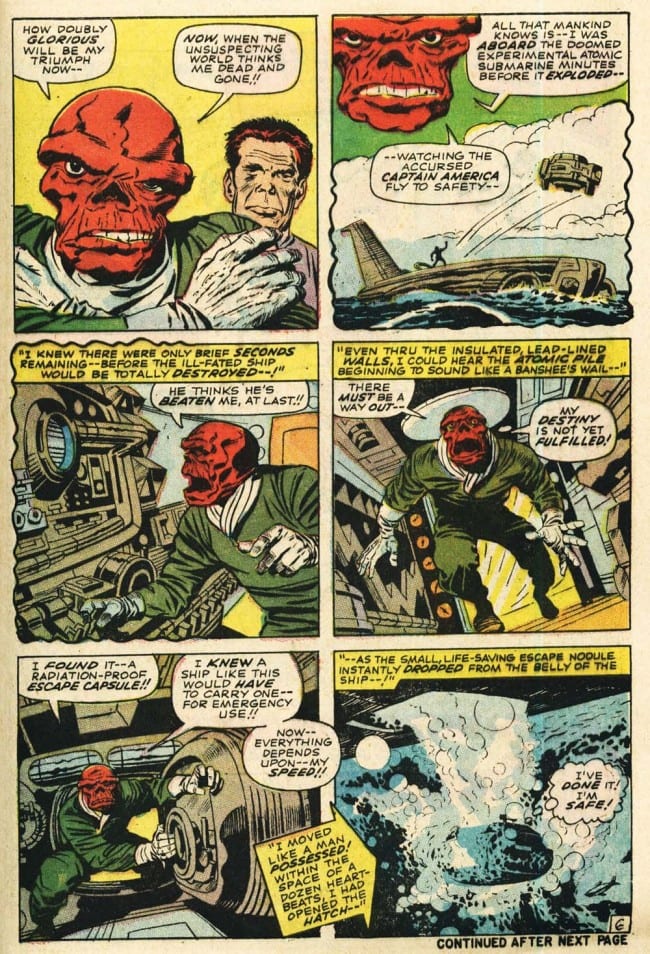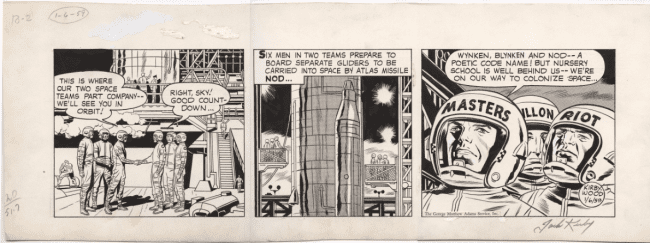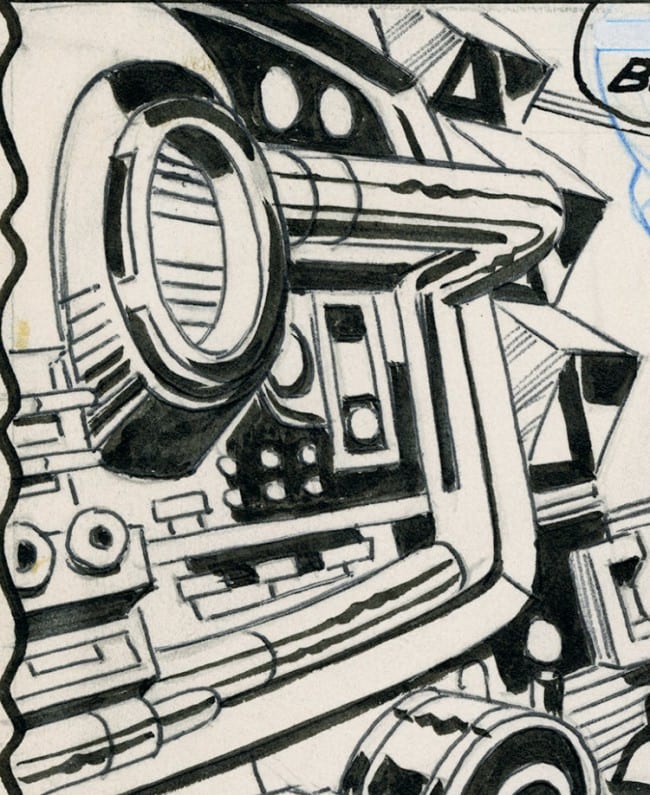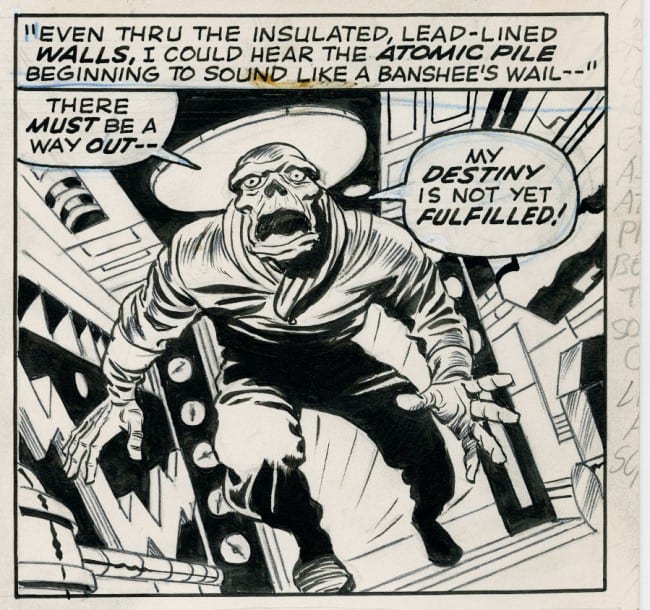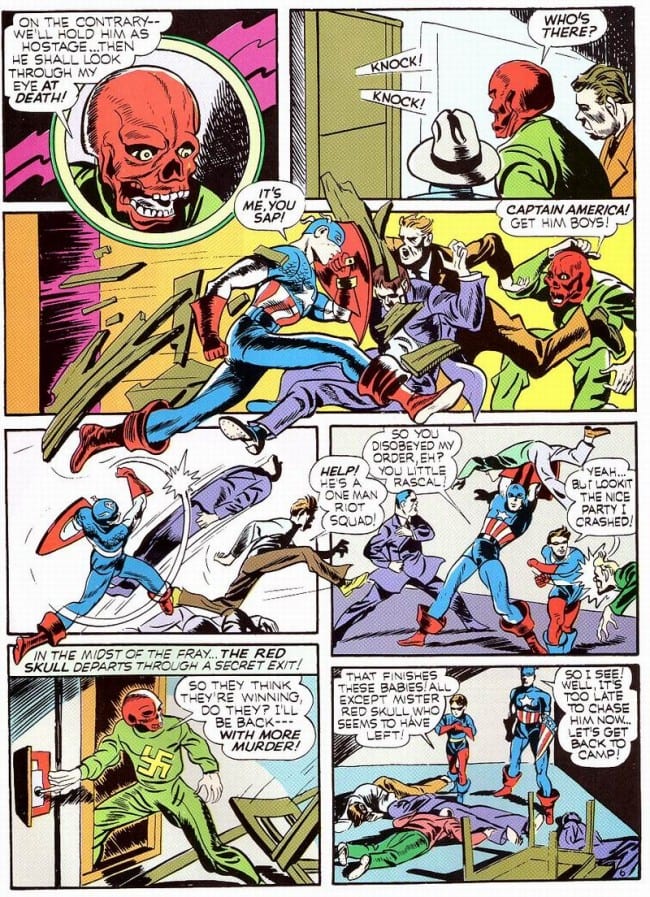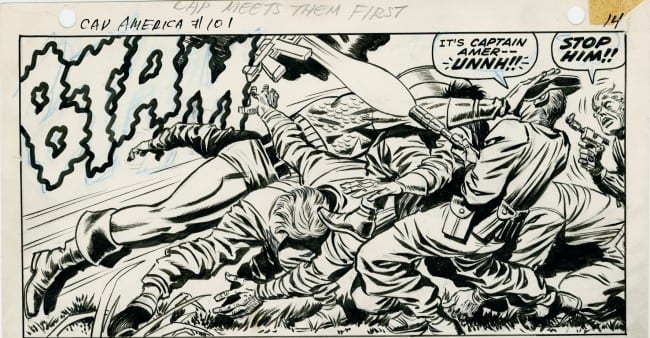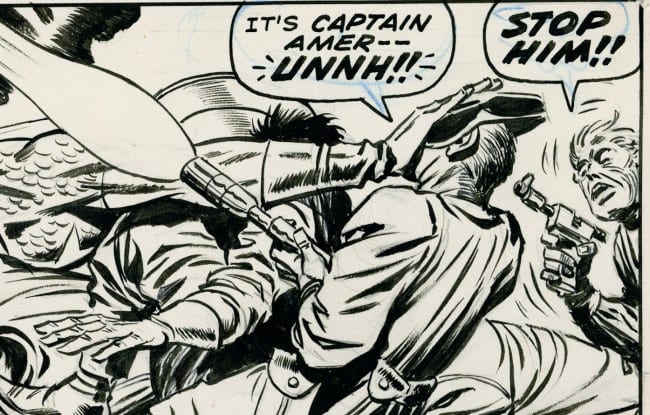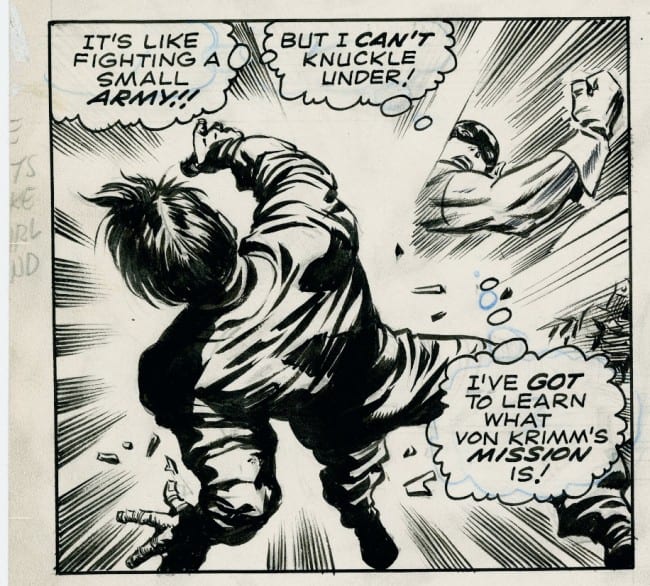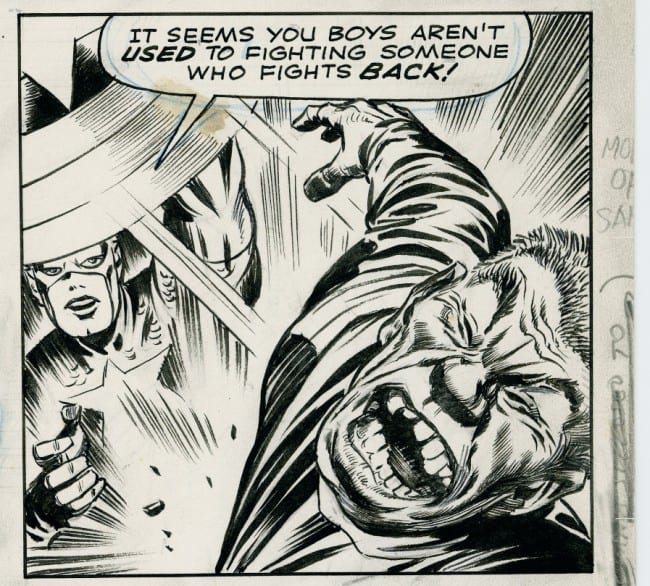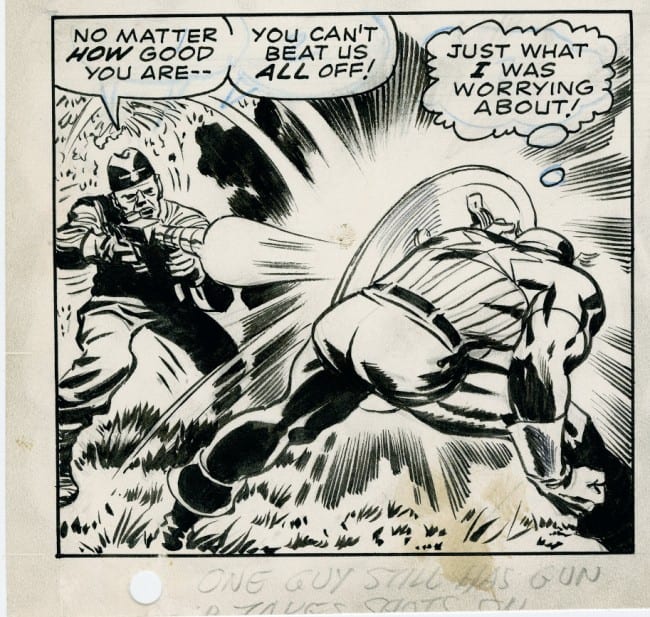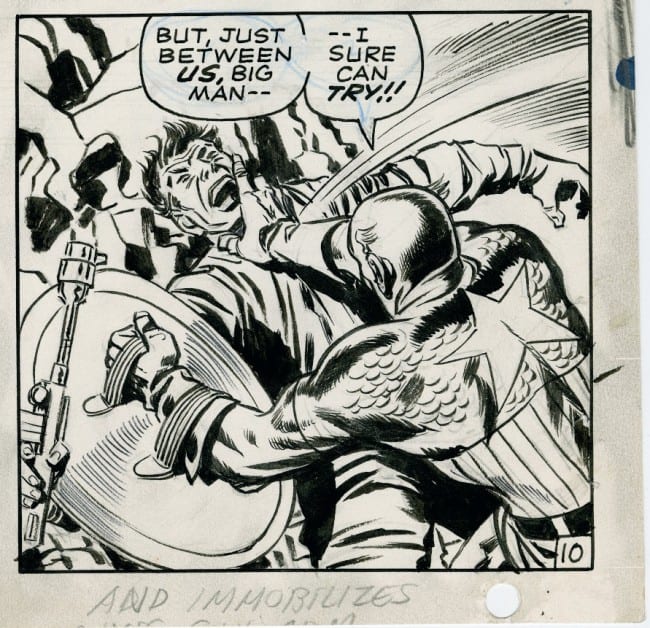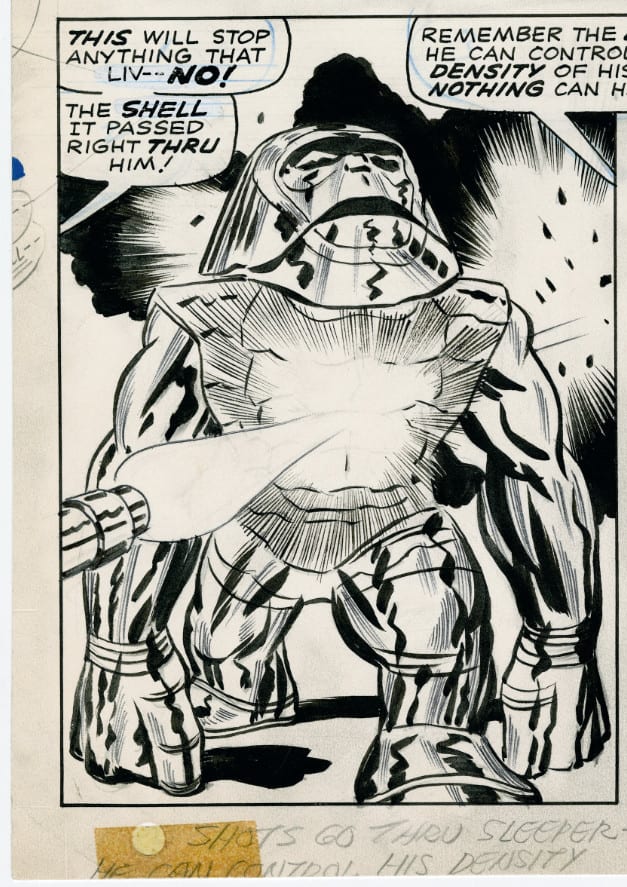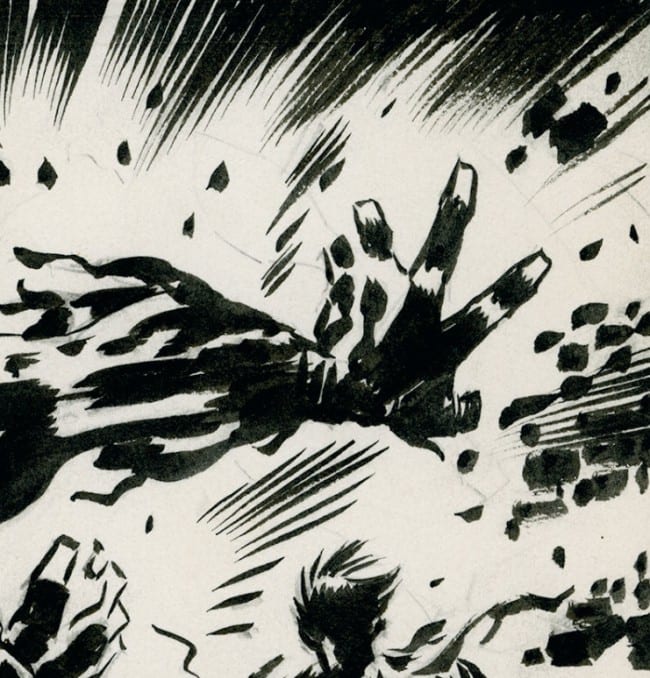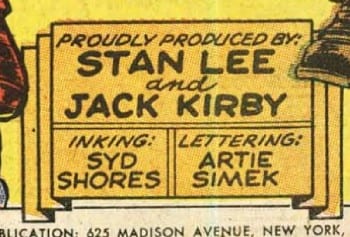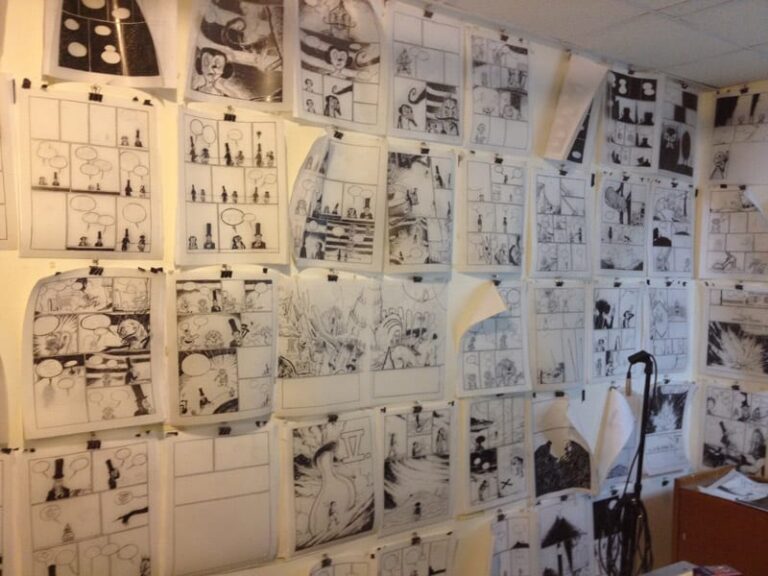I hope you all had a happy holiday season, and I wish you all the best in 2014. This month let’s take a look at some of Jack’s Captain America art. As most of you know, Jack created “The First Avenger” with Joe Simon in Captain America Comics #1 (cover-dated March 1941). Kirby's final monthly issue where he worked on the character was Captain America # 214 (Oct 1977). A pretty remarkable run on a single character although Jack didn’t work on the character for the entire 40-year period. It’s amazing to see how Jack’s style changed over the decades. I’ve said many times that it would be great if Marvel would honor Jack by putting all of his Captain America work together in one nice set of hardcover volumes in a box set -- it would be a great way to highlight the evolution of Jack’s storytelling and it also would be a great way to show how Kirby expressed the middle of the 20th century through the eyes of the iconic patriot and freedom fighter Captain America, but clearly Marvel has no interest in promoting Jack Kirby although they spend billions of dollars promoting films featuring his creations.
These pages are from Captain America # 101 (May 1968). "When Wakes the Sleeper."
The original art scans are from the Jack Kirby Museum's Digital Archive project at kirbymuseum.org . Unfortunately a lot of the margin notes were cut off during production so many are incomplete, especially the ones on the sides of the pages, but we can still make out some of Jack’s directions for Stan Lee. The inker on the book was Syd Shores. Opinions are mixed on the effectiveness of Shores on Kirby’s pencils -- some think he did a solid job, others think his approach was a bit heavy-handed and obscured some of Jack’s vitality -- I enjoyed reading the reprints of these books when I was a comic book fan buying the books off the stands at the local 7-11 in the late 1970s, so although I don’t think Shores did a brilliant job on these books, I like looking at different inkers interpret Jack’s art. I think Shores turned in a solid workmanlike performance and ultimately this is classic 1960s Kirby Captain America. There is a lot of great art in the book; we’ll look at 3 pages.
Captain America # 101, page 6
This page features a pretty standard flashback sequence. Lee prefaced the flashback sequence on the bottom corner of the previous page:
Right in the middle of Jack’s story we have archetypal Lee propaganda. Totally unnecessary -- it's obvious the next page is a flashback explaining why the Red Skull is still alive. This type of aside is the equivalent of a runaway freight train slamming on the breaks -- if there was any sense of real danger or real drama, that is erased by Lee.
Captain America # 101, page 6, panel 1
Jack’s directions for Stan Lee: “Dawn for Red Skull when world thinks my sun has set.” Lee’s text mirrors Jack’s directions -- the Skull announces his triumph will be glorious since the world thinks he’s dead. Stan just changes the words a bit. If Jack had dialogued this panel maybe he would have used the language in his directions for Lee, the concept of the dawn and the setting sun are a bit more profound than Lee’s straightforward, fairly standard bad guy text. Jack's Skull is evil but has some level of sophistication and intellect, even eloquence. Lee's captions turn him into a 1-dimensional bad guy constantly ranting and raving like the campy characters in the '60s Batman TV show. You can see where Lee wrote the word balloons in blue-line pencil and he numbered them 1 and 2. He would type up his captions and give that to the letterer.
Note how Jack makes the Skull's face distorted, emphasizing his evil. He's literally twisted.
Shores' inking gives the face a three-dimensionality and the line variety and texture gives the image a bit of photorealism you don’t see in Jack’s pencils filtered through most of his other inkers, aside from Wallace Wood in the famous Skymasters dailies and Sundays. Here’s an example of Kirby/Wood from my old Kirby Dynamics weblog sent to me by a reader. Beautiful delineation of the machinery and note Wood's distinctive shadows on the faces.
Obviously Wood was a lot slicker than Shores, and Woody was considered a master craftsman as an inker, but I do think Shores was going for this type of effect over Kirby -- less cartoony and drifting a bit towards photorealism -- and in that sense I think Shores was successful although reactions to any artist or approach will be varied.
Captain America # 101, page 6, panel 2
Jack’s directions for Stan Lee: “…atomic super sub where Cap America.” It looks like a sentence or two may have been cut off the top of this panel, it also appears Jack might have made a few more notes in the top right-hand corner. Stan’s captions mirror what we can read in Jack’s directions -- the Skull says he was on an atomic sub and Captain America escaped to safety. This standard comics composition of a close-up of a face at the top of an image discussing a long shot makes it clear we are looking at a flashback, so that’s why I think Lee’s lengthy caption on the previous page was unnecessary from a storytelling perspective.
You can make out some blue line text in the word balloon so as he was reading Jack's story for the first time, before he typed up the captions, Lee may have jotted down some ideas in the balloon. Notice in the margins the remainder of some arrows pointing to that dark area which is a paste-up. To the left, you can barely make out the vertical stabilizer of the craft in pencil under some white-out right over the vertical stabilizer in the paste-up, so Lee probably had someone photocopy the original image and lower it in the composition. Maybe he thought that improved the balance of the composition with the balloons.
Captain America # 101, page 6, panel 3
In the final editing phase it looks like Lee had a staffer add quotations to the caption boxes. The first line of dialogue has white-out underneath so that was changed.
Beautiful example of Kirby-tech. The wonderful, colorful technology pouring out of Jack's books must have been one of the big reasons fans loved his artwork. Shores does a nice job inking this.
Unfortunately Jack’s notes are almost all cut off here. There’s really know way to try and decipher them. Suffice it to say it’s clear Jack gave Lee extensive directions for this panel.
Captain America # 101, page 6, panel 4
Great low angle view of the contemptible Red Skull, emphasizing his terror and panic. Again, Jack’s notes are cut off so I can’t make out what they say, maybe one of you comic book CSIs out there can hazard a guess. It’s worth noting that again Jack has written quite a bit there, but Lee doesn’t express much in the captions other than the Skull is in danger and trying to escape, and that’s obvious in the visual.
Here's a close-up of the Skull's face, his panic is almost comical -- there is an ugly absurdity to evil, and a tremendous irony when a tyrant finds himself in danger. You can see Jack's pencils to the left and right of the face so Shores tweaked the image a bit de-emphasizing the brow.
Captain America # 101, page 6, panel 5
Jack’s directions for Lee: “Skull finds small lead-lined escape cabin – there has to be…” The rest of Jack’s directions are gone. Lee mirrors Jack’s directions in his caption: the Skull (still talking to himself out loud as many comic book characters tend to do) announces to himself that he has found an escape capsule. Notice Lee made some changes to his text at the top, there is white-out under "I knew." "I moved" is also a change.
Shores adds a lot of personality to the Skull on this page. Remember, this guy is a Nazi, the personification of pure evil.
Captain America # 101, page 6, panel 6
It’s a bit hard to make out these directions for Lee since the thin photocopy of the "continued after next page" image is taped to the page (it's remarkable that any of these penciled fragments remain at all). It looks like Jack's directions for Lee say: “Hatch (?) capsule drops from sub.” Stan’s caption mirrors this, although he calls the capsule an escape nodule. The notes on the right side of the page don't look like Lee's handwriting to me so that could be from one of the Marvel staffers. It appears there was a change made to the thought balloon bubbles to try and differentiate them from the bubbles around the submarine. You can also make out minor changes to the arrow (note the white-out) and to the caption box. You can also see Lee changed the first sentence -- the previous text was highlighted in blue line, white-out was applied, and new text added.
Even if you are a harsh critic of Stan Lee, you have to give him credit for working on these stories. Obviously he had his staff make changes like this because he felt they made the books better, and Lee certainly deserved the paycheck and credit for his work as caption writer and editor, I just wish he would have made it clear how important Kirby was in the creation and writing process.
Not an overly spectacular series of images, but a nice example of Kirby using a page to give the reader a flashback sequence explaining a character’s past. Kirby’s visuals and margin notes explain the story to Stan Lee, then Lee follows Kirby’s directions and his text reflects Jack's visuals. It may have been Lee’s idea to bring back the Red Skull character -- Jack tended to enjoy creating new characters -- if it was Lee’s idea, it could have been based on fan requests, so ironically resurrecting the Simon/Kirby Red Skull might not even have been Lee’s original idea. Most of you probably know the Red Skull character was created by Joe Simon and Jack Kirby in Captain America Comics #1 (March 1941). Just to give you a brief idea of how Jack’s style changed from the 1940s through the 1960s, here are pages 33, 34, and 38 from that book featuring the first appearance of Jack and Joe's character.
It's important to remember when Simon and Kirby produced these stories, the world faced terrible danger from the conflict brewing in Europe, and the outcome was anything but certain. Jack and Joe themselves faced danger from Nazi sympathizers in the US who would have been very angry to see this type of anti-Nazi propaganda in 1941. There were a lot of isolationists and pro-Germans living in the country, so Jack and Joe were taking a risk producing this type of flagrant anti-Nazi propaganda, but history has shown they were in the right. Jack and Joe were already heroes fighting fascism and totalitarianism and they were just cartoonists.
From an artistic standpoint, notice how skinny Kirby's characters are, reflecting the way depression era people looked during that time; Jack packs the pages with as many panels as he can squeeze in to give the reader maximum storytelling; and as Jack was so famous for, his characters literally jump off the pages and into the other panels. Even in the 1940s you could argue Kirby was one of the best action choreographers working in the comics medium, and as we've seen over the years, whether you like the action genre or not, Kirby-esque free-for-all fight scenes are the norm now in contemporary television, film, and video games.
To give you another look at Jack’s evolution of style, here is a 4 page sequence from Captain America # 212 (Aug 1977). As far as I’m aware, except for commission pieces, this was the last time Jack ever chronicled the adventures of the Red Skull. Inks by Mike Royer.
Beautiful late-70s comics.
Let's go back again to 1968. Captain America # 101, page 10
Captain America # 101, page 10, Panel 1
There’s not a whole lot to learn from this page in terms of comparing the margin notes to Lee’s captions. It’s all action, so no need for small talk from Jack. Jack’s directions for Lee for this panel are pretty simple: “Cap meets them first.” Brevity is appropriate here, not much to add to this image. Wonderful example of how Jack was constantly coming up with explosive action sequences. Cap begins the fight by hurtling himself into the crowd of thugs, a gun blast obscuring his face, Cap's hand shoving a gunman's hat down into his face, blinding him.
Captain America # 101, page 10, Panel 2
Kirby’s notes are chopped off here, but the image is pretty self-explanatory. Shores inking of the shadows gives the antagonist a real 3-dimensionality you don't see in a lot of Jack's work.
Captain America # 101, page 10, Panel 3
Stan’s dialogue here is pretty good: Cap is being attacked by a bunch of guys used to ganging up on people. We can’t see Jack’s directions, but it’s clear there were only a few words.
Here’s a close-up of the face of that character getting smashed in the face so you can see the details of Shore’s inks; a lot of detail that gets lost in publication when the art is reduced in size. You can also see some notes by Lee were chopped off the side of the page.
Captain America # 101, page 10, Panel 4
Jack’s directions for Lee: “One guy still has a gun (?) takes shots (?)…” The rest of the notes are gone. Great example of Kirby choreographing a battle. In this panel the tide is turning against Cap. You see that kind of ebb and flow in any great fight sequence.
Captain America # 101, page 10, Panel 5
Jack’s directions for Lee: “And immobilizes (?)…”
That’s the end of that battle, at least on this single page. Kind of strange how Lee has Captain America in panel 4 thinking about how he is worried whether he can beat the bad guys in a thought balloon, then Lee has Cap announce in a word balloon to the guy that he sure can try. Doesn’t really make any sense -- how would the gunman have any idea what Captain America is talking about? But I guess it doesn’t really matter what someone is talking about when they are punching you in the face, and maybe Captain America likes to complete some of his thoughts out loud while fighting for his life – that’s Lee adding characterization to Steve Rogers. It’s one of those things no one probably ever noticed, if anyone really paid attention to the dialogue – I suspect the action is what made readers plop down their nickels for these books.
Captain America # 101, page 13
Captain America # 101, page 13, Panel 1
The first panel is a typically spectacular example of what I call a “Kirby entrance,” where a character makes a dramatic appearance in the story. Jack uses a little more than half the page to add emphasis to the introduction of yet another one of his ideas Stan Lee could claim he created and Marvel could exploit for as long as people are willing to support their product. The image features several Kirby motifs he used all the time, the speed lines blasting off the character giving the illusion of light and energy, the rubble and debris flying in all directions, and a gun wielding antagonist in the foreground.
Here's a close-up of the Sleeper, another Kirby creation with a remarkably modern design.
Jack’s directions for Stan Lee say: “Door flies off Sleeper’s container – he is awake, must carry out mission programmed during war.” Lee’s caption mirrors Jack’s directions; Lee tells the reader the character has been dormant for decades. Lee calls the container a crypt, although it’s probably more of a cocoon or a womb that was containing an organism waiting to be born. The rest of Lee’s captions are what I call Stan Lee STO, Lee stating the obvious: in the caption Lee tells the reader the crypt is torn apart and there is an explosion which is obvious; the first gunman tells us the Sleeper is awake, which is obvious; and it lives, which is pretty self-apparent; another character says to stop the Sleeper, which makes common sense (although most people would probably get out of the way); and the final Lee caption has the character with the gun saying he’s going to use the gun, which is what most crooks do when waving around a gun.
Some might think I’m being overly critical of Lee’s captions by calling it STO, but these types of Lee captions don’t really add anything to the story (except where the one gunman says they need to make the Sleeper wait for his master’s command). And this approach to writing dialogue for an action scene is understandable; what could Lee add to an action-packed panel like this? Should Lee have the characters talk about politics or sports? Of course not, that would detract from the power and flow of the images. The characters stating the obvious helps reinforce Jack’s visuals, it clarifies what Jack has going on in the artwork, and helps the story flow forward.
The important point I want to make here is that all of the captions in that panel are superfluous, that panel needs no dialogue at all because the action is clear. But Lee has to add some words to the panels or this isn’t a comic book -- this would just be Kirby storyboards, which is in fact what they were before Lee added his captions. And I know much of this is common sense, but I want to emphasize this point again: Jack Kirby was the Principal (or Primary) Author of this story (he wrote the story first with visuals and directions for Lee). Lee was the Secondary Author (Lee added text based on Jack’s story and art). What I call “The Kirby/Lee Square Dance” is an incredibly non-traditional method of working, and the only reason Kirby/Lee worked like this was because Lee was Jack’s boss so Jack had no say in the matter. At the very least if any writer/artist worked this way in the present, you would hope they would have the integrity to make the division of labor clear in the credits.
Captain America # 101, page 13, panel 2
Jack’s directions for Stan Lee: “Shots go thru Sleeper – he can control his density.” This is clear in the visual, but it probably does need a bit of clarification with some text, so Lee does that -- he has one of the gunmen proclaim that his gunshot went through the Sleeper. Lee has the other gunman explain that the Sleeper can control his density, mirroring verbatim Jack’s directions.
Captain America # 101, page 13, panel 3
Here's a few close-ups of the explosion, I think the Kirby/Shores combination really works on these images. Gives you an idea of the ferocity of combat, and I think when you take bits and pieces of comics art like this and cut out the word balloons it shows that if you put a frame around images like this and hung them in a museum, if you could get a few billionaires to shell out millions of bucks for this material it would be considered fine art by the establishnent that could stand alongside the work of all the fine art masters. Not saying comics with word balloons aren't art, just pointing out the only thing that really separates comics from fine art is the word balloons and sound effects.
Jack’s directions for Stan Lee: “Suddenly hot blast occurs – takes his…” The rest of the notes are chopped off. The first word is hard to make out, but the last two words look like “…by surprise.” So the notes probably say ““Suddenly hot blast occurs – takes his (?) by surprise.” The word might be “guards” since Lee calls them that in the caption. As usual, Lee’s caption states the obvious – there is a blast that blows the gunman away, this is obvious from looking at the image.
This is “Marvel Method” folks. I know there will be those who will argue maybe Lee told Jack to do all of this over the phone in a verbal plot session, but unfortunately we’ll never know if that happened. What we do know is what we can see on these source documents: Jack is directing the movie with visuals and margin notes, Lee is almost like a movie reviewer reporting on what is happening in Kirby's movie -- Lee almost always has the characters and captions mirror Jack’s directions and clarify his visuals. So “Marvel Method” was not Lee coming up with these awesome stories and battle sequences alone, then Kirby was allowed to add an idea to Lee’s story here and there because Lee wanted to give his artists freedom to be creative. Marvel Method in the case of Kirby/Lee appears to be a system where Kirby came up with the bulk of the stories alone in the illustration phase, then Lee contributes an idea here and there in the captions, mainly to simply fill space. This may seem like a cynical interpretation of the source documents to some of you, and obviously this is only a theory -- Lee may have jumped up on his desk and acted out this entire sequence for Kirby, Kirby memorized Lee’s performance, then regurgitated it verbatim in pencil, and Kirby even included directions in the margins in case Lee forgot his own “plot.” To me, common sense and observing a lot of these pages suggests the opposite.
These are not the most spectacular pages from Jack’s Captain America run, but they are another piece of the puzzle giving us a glimpse into the real “collaboration” taking place between Kirby and Lee. I think comparing the notes that survive to Lee’s text make it clear that this credit box at the beginning of this story is a bit misleading.
Yes, in 1968, Kirby had won a small victory -- Lee wasn’t crediting himself as the sole-writer of the stories and crediting Jack as merely the penciler any longer. As a temporary compromise, Lee came up with the “produced by” credit. But since Lee had credited himself as the sole-writer for half-a-decade, I have yet to meet a single person on planet Earth who thought this credit box meant Jack was writing the stories.
To wrap up this month’s column with an image that reflects Jack’s service to his country during the Second World War it’s tempting to continue showing his terrific Foxhole covers, but for today let’s look at what I think is one of Jack’s most brutal images depicting the ferocity of warfare. This is the 2-page spread from DCs Our Fighting Forces # 169 (Oct 1975), inked by Mike Royer.
Incredibly violent stuff for a 1970s four-color comic on the spinner racks at the local drug store. Jack is often criticized for doing stories about superheroes -- many comics intellectuals tend to look down on that genre -- but with this image, Jack shows that he could tackle real issues like war and revolution. And Jack served in World War II so he witnessed this type of violence firsthand. Jack did superhero comics because it was his job, and I think he did them well, but he was more than capable of doing these types of stories showing readers the horror and bloodshed of warfare if a publisher had been interested in this type of material.
Here’s an unpublished Silver Surfer Graphic Novel (1977) 2-page spread that has the same composition as the Our Fighting Forces spread.
Pretty safe to assume Lee rejected this because of its violence, especially the man with the woman on the bed about to bash her brains in. Marvel must have returned the penciled art to Jack (meaning Jack didn't get paid for his work on this) and I guess Jack had Mike Royer ink it for the Jack Kirby Masterworks portfolio (1979).
I love the defiance of the guy pumping his fists at the firing squad. You see that same rebelliousness in the far right corner of the Our Fighting Forces spread. I think Jack would have done a lot more of this type of material if not for the Comics Code. This is one of Jack’s more powerful pages -- its inclusion in the Silver Surfer Graphic Novel would have given that book an added level of realism; its omission was another example of the Kirby/Lee square dance resulting in a product that started off as pure Kirby and ended up being diluted after being filtered through Lee. The important thing to remember is that Jack’s style is so unique, his storytelling so direct and good, and his visuals are so dynamic, you can still see a tremendous amount of Kirby’s vision shining through regardless of who his collaborator was. And if you consider the quantity and quality of Jack’s entire body of work, even if you aren’t a fan of his stories or art, I hope as a fan of the comics medium, you can at least respect Jack Kirby the man for his work ethic and imagination.




